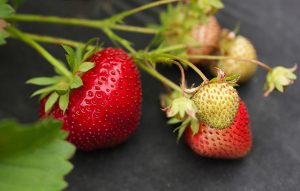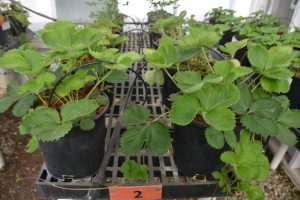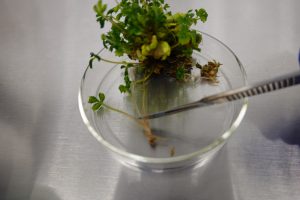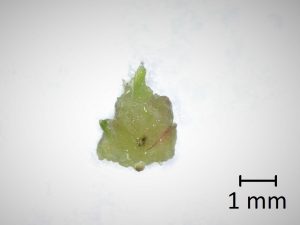Strawberry Shoot Tip Cryopreservation (Droplet Vitrification)

Katheryn Chen, Department of Soil and Crop Sciences, Colorado State University, 307 University Ave., Fort Collins, Colorado 80523.
Gayle M. Volk, USDA-ARS National Laboratory for Genetic Resources Preservation (retired), 1111 S. Mason St., Fort Collins, Colorado 80521. Gayle.Volk@colostate.edu
Kim Hummer, USDA-ARS National Clonal Germplasm Repository, 33447 Peoria Road, Corvallis, Oregon 97333.
Outline
- Introduction
- In vitro cultures and cold acclimation
- Shoot tip excision
- Shoot tip processing and storage
- Shoot tip recovery
- Viability assessment
- References
- Additional information
- Acknowledgments
The strawberry shoot tip cryopreservation procedure is available to download here.
The strawberry shoot tip recovery procedure is available to download here.
1. Introduction
Figure 1. Strawberry fruit at various stages of ripening. Photo credit: USDA Image Gallery.
Strawberry (Fragaria; Fig. 1) is an economically important crop in many countries, with high levels of production in China, the United States, and Mexico. In the United States, the National Plant Germplasm System’s (NPGS) primary collection of strawberry is housed at the National Clonal Germplasm Repository (NCGR) in Corvallis, Oregon (Video 1). Strawberry germplasm is conserved as plants in the field or in screen houses, as in vitro cultures in refrigerated conditions, and may be cryopreserved for long-term storage (Reed and Hummer, 1995).
Strawberry shoot tips may be cryopreserved through a variety of approaches including encapsulation vitrification (Hirai and Sakai, 2001), vitrification (Niino et al., 2003), droplet vitrification (Pinker et al., 2009), and cryo-plate vitrification (Yamamoto et al., 2012). Although the NCGR and the National Laboratory for Genetic Resources Preservation (NLGRP) have applied both vitrification and droplet vitrification to preserve strawberry germplasm, this chapter describes the latter as it tends to produce greater viability.
Video 1. Dr. Kim Hummer, Research Leader at the National Clonal Germplasm Repository, provides an introduction to the National Plant Germplasm System strawberry collection.
2. In vitro cultures and cold acclimation
Figure 2. Potted strawberry plants in National Clonal Germplasm Repository strawberry collection. Photo credit: Gayle Volk.
Healthy potted strawberry plants (Fig. 2) provide a starting point to establish in vitro cultures at NCGR (see “Introduction of clean plant into tissue culture“). These cultures may serve directly for shoot tip cryopreservation at the NCGR, or can be transferred to gas-permeable bags for reduced temperature storage (see “Reduced-temperature storage of temperate crops in tissue culture“). Strawberry kept in reduced temperature storage may later be rewarmed and grown to provide material for shoot tip cryopreservation at NCGR or NLGRP.
Figure 3. In vitro strawberry cultures. Photo credit: Katheryn Chen.
Cultures are maintained on Fragaria Shoot Maintenance Medium (Murashige & Skoog (MS) Basal Medium, 25 g L-1 sucrose, 0.2 mg L-1 BAP, 1.3 g L-1 gellan gum, 3 g L-1 agar at pH 5.8) in containers such as Magenta GA-7 vessels (Fig. 3). Cultures are maintained in an environmentally controlled growth room (~60-90 μmol m-2 s-1 with 16-hour photoperiod at 25 oC) and transferred to fresh medium frequently. Non-contaminated cultures are multiplied until there is enough material; approximately 80 microplants are ideally available to produce the 170 shoot tips needed for cryopreservation.
Figure 4. Dividing strawberry into individual microplants. Photo credit: Katheryn Chen.
From 3- to 4-week-old strawberry cultures, divide small clusters or individual microplants (Fig. 4, Video 2). Plate these onto Fragaria Shoot Maintenance Medium (approximately 16 plants per GA-7 vessel x 5 vessels). Grow these at stock culture conditions (~90 μmol m-2 s-1 or ~7100 lux with 16-hour photoperiod at 25 oC) for one week. Transfer 1-week-old cultures to cold acclimation chamber (~90 μmol m-2 s-1 or ~7100 lux with 8-hour photoperiod at 5 oC) for 2 weeks.
Video 2. Technician Katheryn Chen divides clusters of strawberry plants for cold acclimation prior to cryopreservation.
3. Shoot tip excision
Figure 5. Excised strawberry shoot tip, approximately 2 mm. Photo credit: Katheryn Chen.
After about 2 weeks in cold acclimation, cultures should be ready for shoot tip excision (Video 3). In sterile conditions, place a single cluster under a dissecting microscope. Isolate a single plantlet at a time, and work quickly to prevent the material from drying. Peel or cut away leaves until only a few small leaf primordia remain to protect the meristem, then trim the base so the entire shoot tip is about 2 mm long (Fig. 5). Plate the shoot tips onto a solid Fragaria Preculture Medium (MS Basal Medium, 0.3 M sucrose, 2 M glycerol, 2 g L-1 agar at pH 5.8). Plates of Preculture Medium should be wrapped in cellophane and placed in the darkness at 4 oC for one day.
Video 3. Technician Katheryn Chen excises 2 mm shoot tips from strawberry plants prior to cryopreservation.
4. Shoot tip processing and storage
After the overnight preculture is complete, place shoot tips into a liquid Loading Solution (MS Basal Medium, 2 M glycerol, 0.4 M sucrose at pH 5.8) at room temperature (21 oC). Let shoot tips soak for 20 minutes. Next, transfer the shoot tips to room temperature Plant Vitrification Solution 2 (PVS2; Sakai et al., 1990). Shoot tips should be exposed to PVS2 for 45 minutes. During this time, prepare foil strips and labeled cryovials. Just before the 45 minutes are up, adhere 10 shoot tips onto each foil strip using PVS2. At the 45-minute mark, quickly plunge the foils into liquid nitrogen to freeze.
Freeze labeled cryovials in liquid nitrogen and load one foil strip into each. Cryovials may then be affixed to canes and transferred to the appropriate long-term storage location. The freeze and storage process is demonstrated in Video 4.
Video 4. Technician Katheryn Chen cryopreserves strawberry shoot tips using a droplet vitrification technique.
5. Shoot tip recovery
Recovery of cryopreserved strawberry shoot tips is needed to determine their viability. This process is shown in Video 5. A liquid nitrogen transfer container can be used to transport target cryovials from storage to a laminar flow hood. Quickly remove the cryovial, uncap it, and submerge the foil strip into room-temperature Unloading Solution (MS Basal Medium, 0.8 M sucrose at pH 5.8). Soak the shoot tips for 20 minutes, then plate on Fragaria Recovery Medium (MS Basal Medium, 25 g L-1 sucrose, 0.2 mg L-1 BAP, 1 g L-1 PVP, 8 g L-1 agar at pH 5.8). Wrap the plates and place them in the dark at 25 oC. After two weeks, move the plates to dim fluorescent light for one week (~20-30 μmol m-2 s-1), then full fluorescent light for several more weeks (~60-90 μmol m-2 s-1) before assessing survival and shoot growth.
Video 5. Technician Katheryn Chen recovers cryopreserved strawberry shoot tips for viability assessment.
6. Viability assessment
Figure 6. Strawberry shoot tips grown for 5 weeks on Fragaria Shoot Maintenance Medium. Photo credit: Katheryn Chen.
After about 5 or 6 weeks, shoot tips can be assessed for regrowth or transferred to Fragaria Shoot Maintenance Medium. Viable shoot tips will have grown into small green plants exhibiting clear shoot growth and should minimally exceed 4 mm of growth (Fig. 6). The accession is considered successfully cryopreserved when at least 40% of the tested shoot tips are viable and 60 of the stored shoot tips are assumed to be viable (Jenderek and Reed, 2017).
7. References
Hirai D, Sakai A. 2001. Recovery growth of plants cryopreserved by encapsulation-vitrification. Bulletin of Hokkaido Prefectural Agricultural Experiment Stations 80:55-64.
Jenderek MM, Reed BM. 2017. Cryopreserved storage of clonal germplasm in the USDA National Plant Germplasm System. In Vitro Cellular & Developmental Biology – Plant 53:299-308.
Niino T, Tanaka D, Ichikawa S, Takano J, Ivette S, Shirata K, Uemura M. 2003. Cryopreservation of in vitro-grown apical shoot tips of strawberry by vitrification. Plant Biotechnology 20:75-80.
Pinker I, Halmagyi A, Olbricht K. 2009. Effects of sucrose preculture on cryopreservation by droplet-vitrification of strawberry cultivars and morphological stability of cryopreserved plants. CryoLetters 30:202-211.
Reed BM, Hummer KE. 1995. Conservation of germplasm of strawberry (Fragaria species). In: Bajaj YPS. (editors). Cryopreservation of Plant Germplasm I. Biotechnology in Agriculture and Forestry, Volume 32. Springer, Berlin, Heidelberg. p. 354-370.
Sakai A, Kobayashi S, Oiyama I. 1990. Cryopreservation of nucellar cells of navel orange (Citrus sinensis Osb. var. brasiliensis Tanaka) by vitrification. Plant Cell Reports 9:30-33.
Yamamoto S, Fukui K, Rafique T, Khan NI, Castillo Martinez CR, Sekizawa K, Matsumoto T, Niino T. 2012. Cryopreservation of in vitro-grown shoot tips of strawberry by the vitrification method using aluminium cryo-plates. Plant Genetic Resources 10:14-19.
8. Additional information
The strawberry shoot tip cryopreservation procedure is available to download here.
The strawberry shoot tip recovery procedure is available to download here.
9. Acknowledgments
Citation: Chen KY, Volk GM, Hummer KE. 2021. Strawberry Shoot Tip Cryopreservation (Droplet Vitrification). In: Volk GM (Eds.) Training in Plant Genetic Resources: Cryopreservation of Clonal Propagules. Fort Collins, Colorado: Colorado State University. Date accessed. Available from https://colostate.pressbooks.pub/clonalcryopreservation/chapter/strawberry-cryopreservation/
This training module was made possible by:
Editors: Katheryn Chen, Gayle Volk
Content providers: Katheryn Chen, Kim Hummer
Videographers: Katheryn Chen
This project was funded by the USDA-ARS and by the USDA-NIFA Higher Education Challenge Program grant 2020-70003-30930.
USDA is an equal opportunity provider, employer, and lender. Mention of trade names or commercial products in this article is solely for the purpose of providing specific information and does not imply recommendation or endorsement by the U.S. Department of Agriculture.







